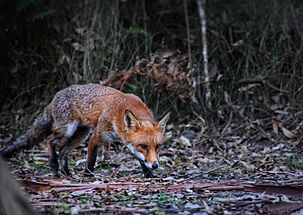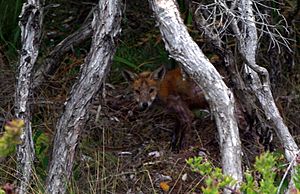Red foxes in Australia facts for kids

Red foxes are a big problem for nature in Australia. In 2012, experts thought there were more than 7.2 million red foxes (Vulpes vulpes) living across most of the country. These foxes were brought to Australia by settlers in the 1830s. Because they spread so quickly and harmed the environment, they are now one of Australia's most damaging invasive species. Even though you can hunt them, it is possible to keep them as pets in New South Wales.
Contents
How Red Foxes Arrived and Spread
Red foxes were first brought to Australia for a traditional English sport called fox hunting. They arrived in places like Van Diemen's Land (now Tasmania) around 1833 and in the Port Phillip District and Sydney areas of New South Wales around 1845.
Interestingly, foxes did not create a lasting population on the island of Tasmania. Many believe the native Tasmanian devils were stronger competitors. But on the mainland, foxes became very successful. Their spread across southern Australia happened at the same time as the spread of rabbits in Australia. Rabbits are another invasive species brought in the 1800s, and they became a main food source for the red fox.
Where Red Foxes Live Now

Today, you can find red foxes in all Australian states. They live almost everywhere except the tropical parts of northern Queensland, the Kimberley, and the Top End of the Northern Territory. Since 2010, there has been proof of foxes in Tasmania, reported by the state's Department of Primary Industries. Foxes are even found more often in busy suburban areas and big cities like Melbourne.
Red foxes are usually less common where dingos live. However, foxes have found their own ways to live alongside feral dogs and feral cats. They do this mainly by digging burrows.
Harm to Nature
The conservation department in Western Australia, called CALM, believes that introduced predators like foxes have caused ten native species in that state to disappear forever.
Red foxes are directly linked to the disappearance and decline of several native animals. This includes the extinction of the Desert rat-kangaroo.
As red foxes spread, many medium-sized animals that live on the ground have become rare. These include brush-tailed bettongs, burrowing bettongs, rufous bettongs, bilbies, numbats, bridled nailtail wallabies, and quokkas. Most of these animals now only live in small areas, like islands, where there are no or very few red foxes.
In 2016, scientists found that some red foxes in Australia had learned to climb trees. They climb to hunt for baby koalas and other animals like gliders. This discovery changed the old belief that tree-dwelling animals were safe from foxes.
Managing and Controlling Foxes
There are programs to get rid of foxes in local areas. However, it's hard to completely remove them because they live in dens and hunt at night. So, the focus is more on managing their numbers. Some states even offer rewards for hunting foxes.
The main way to control foxes is using baits. These baits often contain a poison called 1080 poison. Hunting foxes is legal in all states. People usually shoot them at night using spotlighting or attract them with fox whistles during the day. Hunters identify foxes by the shine from their eyes and their body shape.
Another idea for control is to bring back other animals that compete with foxes. Research by the CSIRO found that having more dingos not only reduces the number of foxes but also helps native animals. Some professors have suggested bringing Tasmanian devils back to the mainland. This could help control foxes, just like they did in Tasmania, and also help the devils survive.
Western Shield Program
In Western Australia, the state government runs a program called Western Shield. They drop baits from planes and place them by hand over a huge area of about 35,000 square kilometers. This helps control foxes and feral cats.
Fox Free Tasmania Program
The Tasmanian government believes that red foxes were brought to the island of Tasmania around 1999 or 2000. Before this, Tasmania had no foxes. Their arrival was a big threat to native animals like the eastern bettong. Because of this, a program was started to get rid of the foxes.


